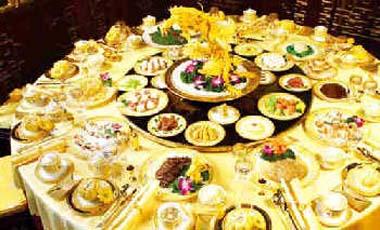The Fangshan Restaurant
The Fangshan Restaurant is located in Yilantang Hall on the north side of the Jade Isle in Beihai Park, where Empress Dowager Cixi (1835--1908) used to take her meals after sight-seeing in the park. The food made in the Qing Palace for the emperors was called imperial food, so a restaurant operating outside the palace making and selling imperial food was only an imitation.
 |
The restaurant's staple food was cooked wheaten products, such as baked sesame seed cakes with fried minced-meat filling and pastries shaped like apple, peach, fingered citron, and lucky rolls. Whatever wheaten food was eaten contained a good luck message: apples= all is well; peach = longevity and lucky rolls = everything is fine.
All cooks in the imperial kitchen were famous. They cooked their dishes to emphasize taste, color, and shape. In addition to the excellent taste, every dish had to look like a work of art. Many cooks specialized in making one or several dishes during their lives. The more their labor was divided, the better the dishes were. What they created was not so much a dish as a valuable work of art. Their excellent cooking skills were the key to the making of palace delicacies.
The dragon and phoenix designs were not used in food appearance in the palace. The dragon and phoenix were the symbols of the emperor and empress so they could not be eaten. Special dishes were created for display such as the snow-white bird's nest which was put in four big bowls with four big Chinese characters that meant a long life. Other display dishes had characters such as: "Moon Festival greetings", "many happy returns of the day", "good luck to you for life" and "New Year's Day greetings".The display dishes were prepared especially to flatter the emperors but they also were delicious in case the emperor wanted to taste them.
Looking through more than 200 years of files from the Qing Palace Imperial Diets there are no dishes with showy names. This suggests that the emperors wanted their ministers to think and act consistently. While the imperial dishes were named differently from those in restaurants, they were very similar to dishes eaten by the common people. Palace cuisine can be regarded as a collection of the best examples of Chinese food. The imperial cooks who started the Fangshan Restaurant in 1925 passed along their cooking skills so that today we can taste imitations of the palace dishes.
